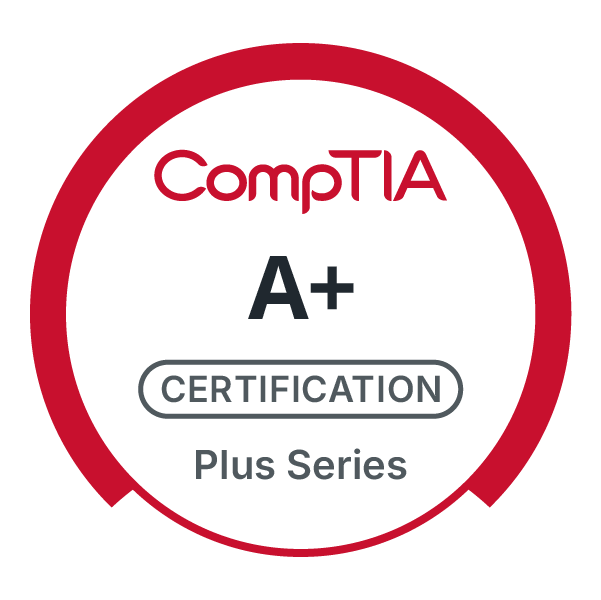
CompTIA A+
CompTIA A+ certified professionals are proven problem solvers. They support today’s core technologies from security to networking to virtualization and more. CompTIA A+ is the industry standard for launching IT careers into today’s digital world.
CompTIA A+ is the only industry recognized credential with performance testing to prove pros can think on their feet to perform critical IT support tasks. It is trusted by employers around the world to identify the go-to person in end point management & technical support roles. CompTIA A+ appears in more tech support job listings than any other IT credential.
Training at a glance
Level
Beginner
Duration
5 Days
Experience
1 year: Basic Computing
Average Salary
$108,170
Labs
Yes
Level
Beginner
Duration
5 Days
Experience
1 year: Basic Computing
Average Salary
$108,170
Labs
Yes
Training Details
The CompTIA A+ Core Series requires candidates to pass two exams: Core 1 (220-1101) and Core 2 (220- 1102) which emphasize the technologies and skills IT pros need to support a hybrid workforce and cover the following new content:
- Increased reliance on SaaS applications for remote work
- More on troubleshooting and how to remotely diagnose and correct common software, hardware, or connectivity problems
- Changing core technologies from cloud virtualization and IoT device security to data management and scripting
- Multiple operating systems now encountered by technicians on a regular basis, including the major systems, their use cases, and how to keep them running properly
- Reflect on the changing nature of the job role, where many tasks are sent to specialized providers as certified personnel need to assess whether it’s best to fix something on site, or to save time and money by sending proprietary technologies directly to vendors
Lesson 1: Installing Motherboards and Connectors
Lesson 2: Installing System Devices
Lesson 3: Troubleshooting PC Hardware
Lesson 4: Comparing Local Networking Hardware
Lesson 5: Configuring Network Addressing and Internet Connections
Lesson 6: Supporting Network Services
Lesson 7: Summarizing Virtualization and Cloud Concepts
Lesson 8: Supporting Mobile Devices
Lesson 9: Supporting Print Devices
Lesson 10: Configuring Windows
Lesson 11: Managing Windows
Lesson 12: Identifying OS Types and Features
Lesson 13: Supporting Windows
Lesson 14: Managing Windows Networking
Lesson 15: Managing Linux and macOS
Lesson 16: Configuring SOHO Network Security
Lesson 17: Managing Security Settings
Lesson 18: Supporting Mobile Software
Lesson 19: Using Support and Scripting Tools
This course is designed for individuals who have basic computer user skills and who are interested in obtaining a job as an entry-level IT technician. This course is also designed for students who are seeking the CompTIA A+ certification and who want to prepare for the CompTIA A+ Core 1 220-1101 Certification Exam and the CompTIA A+ Core 2 220-1102 Certification Exam.
- Recognize the main components of a PC as well as storage media such as USB drives and DVD.
- Start the computer and navigate the operating system desktop.
- Use Windows Explorer to create directories and subdirectories and manage files.
- Use a web browser to view websites.
Upcoming Classes
We offer more than just CompTIA Training
That’s because we provide everything you need to succeed. This is true for all of our courses.
Strategic Planning & Project Management
From Lean Six Sigma to Project Management Institute Project Management Professional, Agile and SCRUM, we offer the best-in-class strategic planning and project management training available. Work closely with our seasoned multi-decade project managers.
IT & Cybersecurity
ATA is the leading OffSec and Hack the Box US training provider, and a CompTIA and EC-Council award-winning training partner. We offer the best offensive and defensive cyber training to keep your team ahead of the technology skills curve.
Leadership & Management
Let us teach your team the high-level traits and micro-level tools & strategies of effective 21st-century leadership. Empower your team to play to each others’ strengths, inspire others and build a culture that values communication, authenticity, and community.
